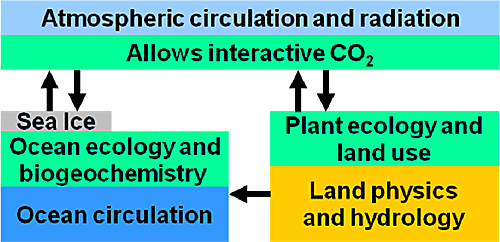Development of NOAA’s first Earth System Model
John P. Dunne et al. Journal of Climate (in prep)
NOAA’s Geophysical Fluid Dynamics Laboratory has developed NOAA’s first Earth System Model (ESM). The successful development of the Earth System Model allows improved understanding of climate and ecosystems. Simulations produced by these models are crucial for assessing the causes, and understanding observed changes in climate and ecosystems, as well as for making projections of future changes.
NOAA has a long history of developing world class physical climate models. One of the deficiencies of this class of models is that they treat carbon dioxide and other radiatively important atmospheric species as external inputs. One of the emerging scientific frontiers associated with efforts to make future climate projections is to simulate the biological and geochemical cycles which allow exchanges between climate and land and ocean ecosystems, through the carbon cycle and other factors. Over the past several years, the GFDL has developed new components that simulate biological systems and chemical cycles. Once these components were developed, they were incorporated into a single model, called an Earth System Model. The model integrates atmosphere, land, sea ice and ocean components, as well as terrestrial vegetation and soil carbon and ocean biogeochemistry components to treat carbon internally within the model.
The development of this model allows us to study the relationship between the biology important for the global carbon cycle, the chemicals important for the biology and climate. Understanding these interactions is very important for making accurate projections of future climate change.
The ESM also allows NOAA to participate in the Fifth IPCC Assessment. These Assessments are the scientific basis for Congress to consider carbon reduction measures such as the Cap and Trade Bill and for the US to enter into (or not) agreements with other countries to limit carbon emissions. The successful completion of this model is an important contribution to the Nation, and the world, in providing critical input for the next international scientific assessments of climate change.

References
Shevliakova, Elena, S W Pacala, S Malyshev, P C D Milly, and Lori T Sentman, et al., 2009: Carbon cycling under 300 years of land use change: Importance of the secondary vegetation sink. Global Biogeochemical Cycles, 23, GB2022, doi:10.1029/2007GB003176.
Dunne, J. P., Armstrong, R. A., Gnanadesikan, A., and Sarmiento, J. L., 2005:Empirical and mechanistic models for the particle export ratio, Global Biogeochem. Cy., 19, GB4026, doi:10.1029/2004GB002390.
Click here to return to my home page.
Click here to find out more about our work on Earth System Model development.


